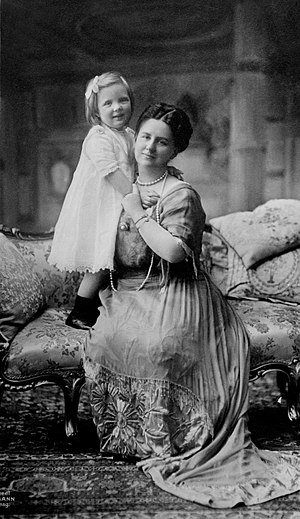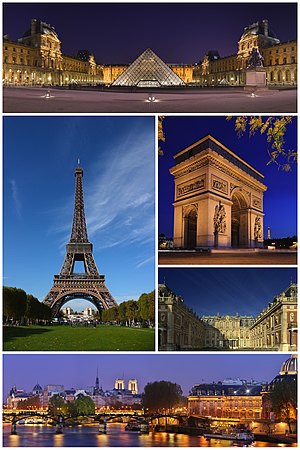Portal:Europe
| Main | Geography | Projects |
|
|
Europe is a continent located entirely in the Northern Hemisphere and mostly in the Eastern Hemisphere. It comprises the westernmost peninsulas of the continental landmass of Eurasia, and is bordered by the Arctic Ocean to the north, the Atlantic Ocean to the west, the Mediterranean Sea to the south, and Asia to the east. Europe is commonly considered to be separated from Asia by the watershed of the Ural Mountains, the Ural River, the Caspian Sea, the Greater Caucasus, the Black Sea, and the waterways of the Turkish Straits. Although much of this border is over land, Europe is generally accorded the status of a full continent because of its great physical size and the weight of history and tradition.
Europe covers about 10,180,000 km2 (3,930,000 sq mi), or 2% of the Earth's surface (6.8% of land area), making it the second smallest continent (using the seven-continent model). Politically, Europe is divided into about fifty sovereign states, of which Russia is the largest and most populous, spanning 39% of the continent and comprising 15% of its population. Europe had a total population of about 741 million (about 11% of the world population), as of 2018. The European climate is largely affected by warm Atlantic currents that temper winters and summers on much of the continent, even at latitudes along which the climate in Asia and North America is severe. Further from the sea, seasonal differences are more noticeable than close to the coast.
The history of Europe concerns itself with the discovery and collection, the study, organization and presentation and the interpretation of past events and affairs of the people of Europe since the beginning of written records. During the Neolithic era and the time of the Indo-European migrations, Europe saw human inflows from east and southeast and subsequent important cultural and material exchange. The period known as classical antiquity began with the emergence of the city-states of ancient Greece. Later, the Roman Empire came to dominate the entire Mediterranean basin. The fall of the Roman Empire in AD 476 traditionally marks the start of the Middle Ages. Beginning in the 14th century a Renaissance of knowledge challenged traditional doctrines in science and theology. Simultaneously, the Protestant Reformation set up Protestant churches primarily in Germany, Scandinavia and England. After 1800, the Industrial Revolution brought prosperity to Britain and Western Europe. The main European powers set up colonies in most of the Americas and Africa, and parts of Asia. In the 20th century, World War I and World War II resulted in massive numbers of deaths. The Cold War dominated European geo-politics from 1947 to 1989. After the fall of the Iron Curtain, the European countries grew together.
The culture of Europe is rooted in the art, architecture, film, different types of music, economic, literature, and philosophy that originated from the continent of Europe. European culture is largely rooted in what is often referred to as its "common cultural heritage".
The economy of Europe comprises more than 744 million people in 50 countries. The formation of the European Union (EU) and in 1999, the introduction of a unified currency, the Euro, brings participating European countries closer through the convenience of a shared currency and has led to a stronger European cash flow. The difference in wealth across Europe can be seen roughly in former Cold War divide, with some countries breaching the divide (Greece, Estonia, Portugal, Slovenia and the Czech Republic). Whilst most European states have a GDP per capita higher than the world's average and are very highly developed (Liechtenstein, Luxembourg, Monaco, Andorra, Norway, Sweden, Denmark, Netherlands, Switzerland, United Kingdom, Ireland, Germany), some European economies, despite their position over the world's average in the Human Development Index, are poorer.
Featured article -
During its 69-year history, the Soviet Union usually had a de facto leader who would not necessarily be head of state or even head of government but would lead while holding an office such as Communist Party General Secretary. Under the 1977 Constitution, the chairman of the Council of Ministers, or premier, was the head of government and the chairman of the Presidium of the Supreme Soviet was the head of state. The office of the chairman of the Council of Ministers was comparable to a prime minister in the First World whereas the office of the chairman of the Presidium was comparable to a president. In the ideology of Vladimir Lenin, the head of the Soviet state was a collegiate body of the vanguard party (as described in What Is to Be Done?).
Following Joseph Stalin's consolidation of power in the 1920s, the post of the general secretary of the Central Committee of the Communist Party became synonymous with leader of the Soviet Union, because the post controlled both the Communist Party and the Soviet government both indirectly via party membership and via the tradition of a single person holding two highest posts in the party and in the government. The post of the general secretary was effectively abolished in 1934 under Stalin, though it technically continued in existence until 1952, and was later re-established by Nikita Khrushchev under the name of the first secretary. In 1966, Leonid Brezhnev reverted the office title to its former name. Being the leader of the Communist Party of the Soviet Union, the office of the general secretary was the highest in the Soviet Union until 1990. The post of general secretary lacked clear guidelines of succession, so after the death or removal of a Soviet leader the successor usually needed the support of the Political Bureau (Politburo), the Central Committee, or another government or party apparatus to both take and stay in power. The President of the Soviet Union, an office created in March 1990, replaced the general secretary as the highest Soviet political office. (Full article...)Featured location -
Omaha Beach was one of five beach landing sectors of the amphibious assault component of Operation Overlord during the Second World War.
On June 6, 1944, the Allies invaded German-occupied France with the Normandy landings. "Omaha" refers to an 8-kilometer (5 mi) section of the coast of Normandy, France, facing the English Channel, from east of Sainte-Honorine-des-Pertes to west of Vierville-sur-Mer on the right bank of the Douve river estuary. Landings here were necessary to link the British landings to the east at Gold with the American landing to the west at Utah, thus providing a continuous lodgement on the Normandy coast of the Baie de Seine (Bay of the Seine river). Taking Omaha was to be the responsibility of United States Army troops, with sea transport, mine sweeping, and a naval bombardment force provided predominantly by the United States Navy and Coast Guard, with contributions from the British, Canadian and Free French navies. (Full article...)Featured portrait
 |
In the News
- 14 February 2024 – Russian invasion of Ukraine
- Crimea attacks
- Ukraine claims to have sunk the Russian ship Tsezar Kunikov off the coast of Katsiveli, Crimea. A video appears to show the vessel being struck with unmanned surface drones. (Radio Free Europe/Radio Liberty)
- 13 February 2024 – Estonia–Russia relations
- Prime Minister of Estonia, Kaja Kallas, is reportedly placed on the Russian Interior Ministry's register of wanted people due to the country's removal of Soviet War Memorials, making Kallas the first known government leader to be added to a wanted list by Russian authorities. (The Guardian)
- 12 February 2024 – Israel–Hamas war
- Israel–Netherlands relations
- A Dutch appeals court orders a suspension of exports of F-35 jet parts to Israel within the next seven days over concerns that the aircraft parts are being used to commit serious violations of international humanitarian law. Prime Minister Mark Rutte says that the government will appeal the suspension. (Reuters)
- 12 February 2024 – Israel–United Kingdom relations
- British Foreign Secretary David Cameron announces sanctions against four Israeli settlers for engaging in extremist violence towards Palestinians in the occupied-West Bank. (Al Jazeera)
Updated: 16:33, 14 February 2024
Categories
Featured biography -
Nestor Apollonovich Lakoba (1 May 1893 – 28 December 1936) was an Abkhaz communist leader. Lakoba helped establish Bolshevik power in Abkhazia in the aftermath of the Russian Revolution, and served as the head of Abkhazia after its conquest by the Bolshevik Red Army in 1921. While in power, Lakoba saw that Abkhazia was initially given autonomy within the USSR as the Socialist Soviet Republic of Abkhazia. Though nominally a part of the Georgian Soviet Socialist Republic with a special status of "union republic," the Abkhaz SSR was effectively a separate republic, made possible by Lakoba's close relationship with Joseph Stalin. Lakoba successfully opposed the extension of collectivization of Abkhazia, though in return Lakoba was forced to accept a downgrade of Abkhazia's status to that of an autonomous republic within the Georgian SSR.
Popular in Abkhazia due to his ability to resonate with the people, Lakoba maintained a close relationship with Stalin, who would frequently holiday in Abkhazia during the 1920s and 1930s. This relationship saw Lakoba become the rival of one of Stalin's other confidants, Lavrentiy Beria, who was in charge of the Transcaucasian Socialist Federative Soviet Republic, which included Georgia. During a visit to Beria in Tbilisi in December 1936, Lakoba was poisoned, allowing Beria to consolidate his control over Abkhazia and all of Georgia and to discredit Lakoba and his family as enemies of the state. Rehabilitated after the death of Stalin in 1953, Lakoba is now revered as a national hero in Abkhazia. (Full article...)Featured picture
 |
Related portals
Major Religions in Europe
Northern Europe
Western Europe
Central Europe
Central and Eastern Europe and Caucasus
Southern Europe
Featured panorama
 |
Topics
Associated Wikimedia
The following Wikimedia Foundation sister projects provide more on this subject:
-
Commons
Free media repository -
Wikibooks
Free textbooks and manuals -
Wikidata
Free knowledge base -
Wikinews
Free-content news -
Wikiquote
Collection of quotations -
Wikisource
Free-content library -
Wikispecies
Directory of species -
Wikiversity
Free learning tools -
Wikivoyage
Free travel guide -
Wiktionary
Dictionary and thesaurus


























